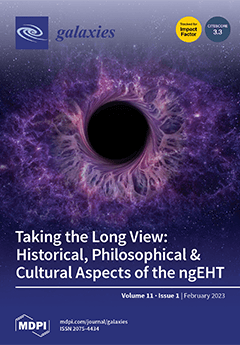Open AccessArticle
The ngEHT Analysis Challenges
by
Freek Roelofs, Lindy Blackburn, Greg Lindahl, Sheperd S. Doeleman, Michael D. Johnson, Philipp Arras, Koushik Chatterjee, Razieh Emami, Christian Fromm, Antonio Fuentes, Jakob Knollmüller, Nikita Kosogorov, Hendrik Müller, Nimesh Patel, Alexander Raymond, Paul Tiede, Efthalia Traianou and Justin Vega
Cited by 23 | Viewed by 2668
Abstract
The next-generation Event Horizon Telescope (ngEHT) will be a significant enhancement of the Event Horizon Telescope (EHT) array, with ∼10 new antennas and instrumental upgrades of existing antennas. The increased
-coverage, sensitivity, and frequency coverage allow a wide range of new
[...] Read more.
The next-generation Event Horizon Telescope (ngEHT) will be a significant enhancement of the Event Horizon Telescope (EHT) array, with ∼10 new antennas and instrumental upgrades of existing antennas. The increased
-coverage, sensitivity, and frequency coverage allow a wide range of new science opportunities to be explored. The ngEHT Analysis Challenges have been launched to inform the development of the ngEHT array design, science objectives, and analysis pathways. For each challenge, synthetic EHT and ngEHT datasets are generated from theoretical source models and released to the challenge participants, who analyze the datasets using image reconstruction and other methods. The submitted analysis results are evaluated with quantitative metrics. In this work, we report on the first two ngEHT Analysis Challenges. These have focused on static and dynamical models of M87* and Sgr A* and shown that high-quality movies of the extended jet structure of M87* and near-horizon hourly timescale variability of Sgr A* can be reconstructed by the reference ngEHT array in realistic observing conditions using current analysis algorithms. We identify areas where there is still room for improvement of these algorithms and analysis strategies. Other science cases and arrays will be explored in future challenges.
Full article
►▼
Show Figures





